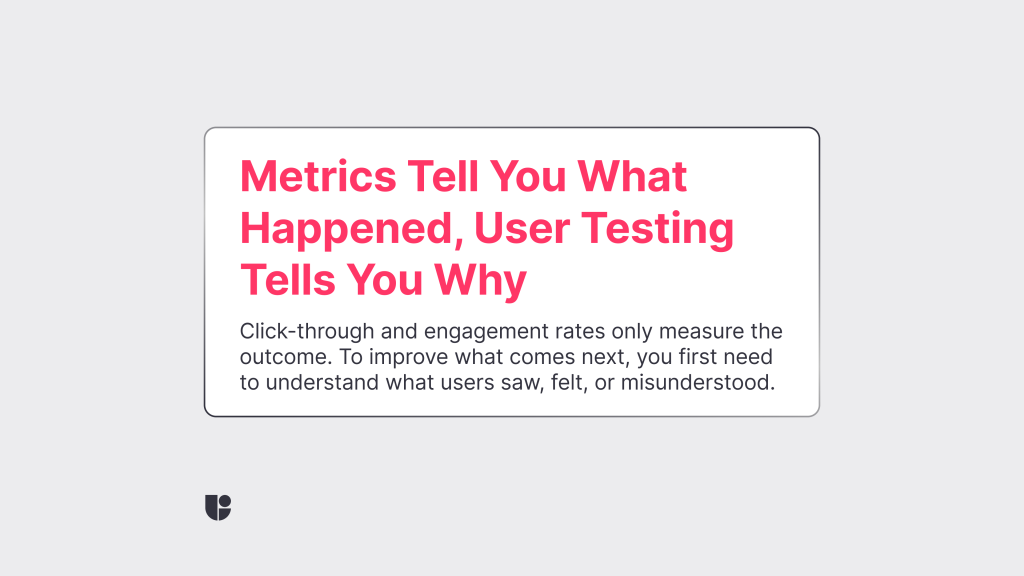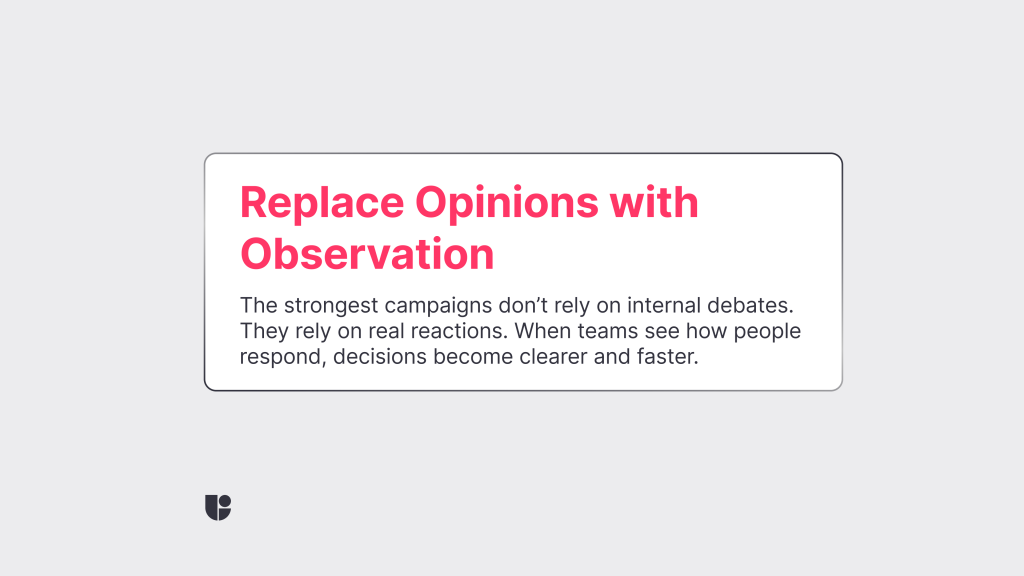We marketers love our numbers. Clicks, conversions, bounce rates, ROIs, and every other KPI that we can fit on a sheet. We track every move our audiences make. We pull up benchmarks, compare with past performance but while we are busy chasing performance metrics, we don’t always stop to ask why those numbers look the way they do. Behind every chart and heatmap is a human experience. User testing insights reveal that experience, the missing layer between your creative ideas and your conversion data.
The Blind Spot in Marketing
Analytics show what happened but we can’t know for sure the “why” without user testing.
Let’s say your ad campaign gets a healthy click-through rate but the landing page barely converts. You can guess the reasons: maybe users didn’t like what they saw after clicking, maybe the page took too long to load, maybe the copy didn’t match the ad’s promise.
What about the people who didn’t click? Did they find the offer confusing? Did the visual miss the mark? Was the CTA button buried or unclear?

We can spend days inside dashboards and still not know. If we only rely on click rates and retention metrics or engagement KPIs, we are measuring the outcome without understanding the cause. That makes it hard to improve the next campaign with confidence. Which is why we need to make it clear that user testing is not just for UX or product teams. It give you real reactions from real people before your campaign ever goes live.
Turning Research into Campaign Fuel
The good news is that marketers don’t need to become UX researchers to start testing. A few small studies can uncover big opportunities to refine your message and visuals. Here are a few ways to apply user testing insights directly to marketing work:
1. Landing page clarity
Run a 5-second test to see what visitors understand at first glance. If your offer, product, or value isn’t clear, you’ll spot it instantly.
2. Ad creative decisions
Use preference testing to compare ad versions, identify which visual grabs attention faster, which headline feels more trustworthy, and which message fits the audience better.
3. Conversion flow friction
A short website usability test on your signup or checkout flow shows where people hesitate or drop off. Sometimes, the smallest detail such as a button label or form step causes a major drop-off.
4. Message and tone check
Run a quick survey to ask what people think the ad or page is offering. You might be surprised by how far perception drifts from intention.

Ok, you are familiar with making a questionnaire but not sure how to run the other test? You can visit the Useberry website to try the testing demos and see how easy it is to setup and run a user testing study. These simple tests fit right into campaign timelines. You don’t need a research department or a six-week setup. You just need a free afternoon and the right tool.
If you would like to see this research in action, take a look at how Infinum uses Useberry to test messaging and visual clarity on their website projects. The insights helped them refine their pages, align design with audience expectations, and move faster from concept to validation.
Small Test, Big Lesson: The Case of the “Perfect” Landing Page
I remember a campaign that I was very proud about a few years back. Where the creative looked strong, polished visuals, clean copy, and a CTA that matched our ads perfectly. However, the early results were barely fine but nothing stellar.
Instead of guessing, we ran a 5-second test on the landing page using Useberry and asked participants: “What do you think this page is about?” The answers came back mixed. Half of them got it right. The other half thought the first impression reflected something completely different.
We tweaked the copy and make the headlines less “clever” and more direct. Ran a preference test on two new visual drafts, and relaunched with the top choice. The conversion rate shot up. That’s the power of user testing. A few minutes of validation turned a good campaign into a great one, and we learned something to apply to every campaign afterward.
What Great Marketing Teams Learn from UX
UX teams live by one principle: test early, learn fast. Marketers can do the same instead what usually happens, which is using campaigns themselves as testing grounds. By integrating user testing into creative reviews, you build a loop that goes beyond opinions and guesswork. Designers, copywriters, and marketers start speaking the same language, the language of real user behavior.
How much time did you spend discussing which version of a creative or a slogan to go with? Instead of debating which ad will work better, you can show it. Instead of assuming your landing page is intuitive, you can confirm it.
Once you’ve run a few of these tests, they become second nature. You start planning campaigns around user understanding, not just performance goals.

From Insight to Action
So to sum up the points: If you want to connect your creative performance to real audience understanding, start with a simple user test for quick and easy feedback. This small addition to your workflow gives you user insights that marketing numbers alone can’t provide. They show what’s clear, what’s confusing, and what drives people to act.
Your Next Great Campaign Starts with a Test
Try Useberry and see how your users really respond




